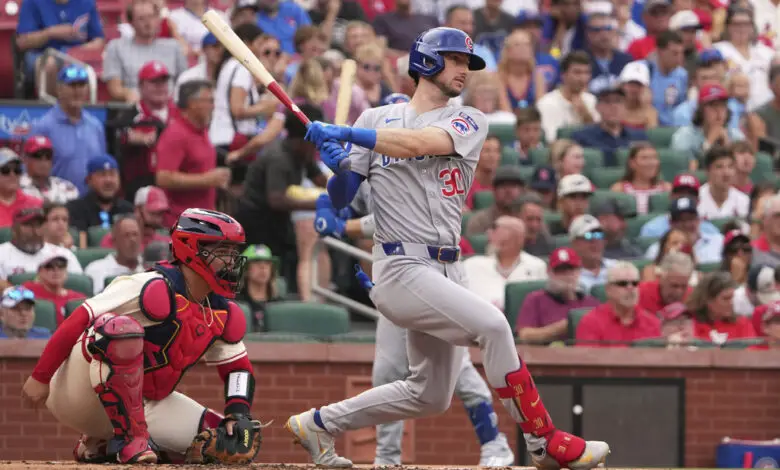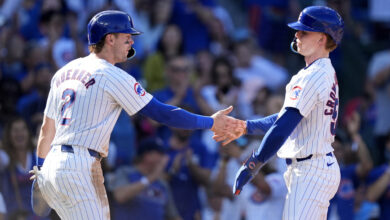
Kyle Tucker Addresses Hand Injury Before Returning to Lineup
Kyle Tucker is back in the lineup for Thursday’s finale with the Brewers after sitting out the Cubs’ three wins in the series. He played in the opener, going 0-for-4 with three weak grounders to the right side and looking very much like a man in need of a break. Now that he’s had a couple of days off to take a small step back and reset both mentally and physically, the Cubs are hoping he can correct some of what got sideways following the hand fracture he suffered at the start of June.
There was a mild uproar in the wake of the report that Tucker’s hand injury was worse than previously disclosed, especially when it came out that he’d declined an IL stint. But when you look at the numbers, it’s easy to see why he opted against going on the shelf. The right fielder batted .311 with five homers and a 173 wRC+ in June, making it his best month of the season. And he got better as the month went on, hitting .367 with four homers and a 216 wRC+ in the last half of the month.
“I thought it would just go away,” Tucker told reporters prior to returning to the lineup on Thursday. “It stuck around for a little bit, but kept playing and I felt fine. Obviously after a while, it kind of turned.”
As has been discussed here and elsewhere, it may have been a matter of small compensatory adjustments eventually leading to changes that no longer served him well. That said, it’s almost like a switch flipped in July. Tucker hit .205 with no homers and a 61 wRC+ in 53 plate appearances prior to the break, but then he bounced back with a 154 wRC+ in his last 49 PAs of July. However, he hit just one homer as his production was fueled far too heavily by an unsustainably high walk rate that was near 21% for the month.
That wasn’t so bad when his strikeout rate remained low, but things flipped in August. Through 61 PAs this month, Tucker is batting .148 with no homers and a 16 wRC+ while striking out nearly three times as often as he walks. I still believe taking a foul ball to the knee on July 22 precipitated some of these issues, but Tucker and the Cubs maintain that it’s just a matter of falling away from his best mechanics.
“I don’t know how much it really affected my setup and my swing and everything,” he said. “I mean, it didn’t feel great at the time, but I could kinda tell with it, obviously you just make adjustments and go out there and play. I’m sure other people have some things going on too that they just play with and make the adjustment with, so it’s just kinda how things go.”
As strong as the desire may be to point (fractured) fingers and assign varying degrees of fault to all the parties involved, this seems like a case in which everyone knew the score. Tucker and the Cubs were aware of the extent of his injury and his initial performance did nothing to dissuade them from the strategy they chose to implement. It wasn’t until August that things took a turn for the worse in a way that required proactive mitigation, which is what brings us to where we are now.
Tucker understandably wants to be at his best, both for the team and his own livelihood, and hitting the IL with another fracture after losing most of last season to one in his leg might have made him look like damaged goods. Not that playing through it and watching his performance go down the drain helped matters, especially now that the diagnosis is out. To that end, I’m not sure who this helps or hurts the most.
For Tucker, it’s an explanation (or excuse) for his poor play. It’s also a possible red flag for him as being injury-prone. The Cubs had no reason to believe the hand was causing a problem, and they were unable to place him on the IL once his production fell off because the hand was healed by that point. Of course, they were also overly stubborn when it came to giving him time to recalibrate, and we have all seen them fumble the bag with IL stints in the past.
I’d wager there’s more to this than just Tucker’s health and performance, especially when we’re talking about a guy who stands to land a big contract this offseason. It’s not just the player and manager, it’s the front office and likely Tucker’s agent as well. All we can do at this point is hope that taking some time this week, and maybe at certain points in the future as well, helps to get the All-Star right fielder back on track.
As for whether and how this impacts the Cubs’ willingness or ability to sign Tucker to a free-agent deal, well, that’s an open question. While I don’t believe there’s any bad blood between the two parties, at least not the kind that can’t be worked through with enough money, it’s a wrinkle in the process for sure. So is Owen Caissie, though there’s still a big difference between a proven star and a rookie with a small sample of success.
Now we just wait and see what happens.
Ed. note: When thinking about the delayed onset of Tucker’s struggles following the mechanism of injury itself, I am reminded of cows’ hooves. Seriously. I’ve gotten hooked on The Hoof GP, a hoof trimmer in southwest Scotland who’s got a booming YouTube channel. There are countless cases of otherwise healthy cattle suddenly going lame, but that lameness is rarely immediate.
While the cause may have been acute in nature, it takes time for the inflammation and/or infection to build up enough that it warrants treatment. Definitely can’t treat people the same way, and there’s a difference between feet/hooves and hands, but this is just where my mind went and I felt like sharing away from the main body of the post.

